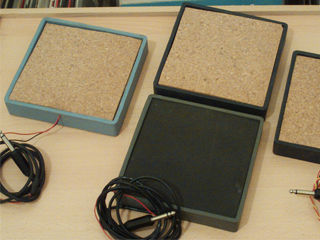Leonardo has been working on a laser-head RepRap for some time. His latest experiment was etching a PCB with it. Above is the video of the first tests, but go on over to his blog to check out all the details.
Category: Projects
food for your stomach

Feeding 15 sleep deprived hackers is not an easy task and during the AZ Residency only 3 people were brave enough to put their culinary talents to the test: Joel, Vitor and Mariana. Everyone agreed that their homemade meals were awesome and no bug reports were filed. Since we believe in sharing, here are Joel’s delicious open source recipes (in french comme il faut):
Salad Dressing [ VO ]
4 cuillère à soupe d’huile d’olive
3 cuillère à soupe de vinaigre balsamique
2 cuillère à café de miel
sel
poivre
Goûter et ajuster : si trop sucré, ajouter du vinaigre / si trop amer, ajouter du miel.
Bask Chicken [ VO ]
Prévoir un bon morceau de poulet pour chacun des invités
Poivron
Tomate
Sauce tomate
Oignon
sel
poivre
Eau
makerbot as microscope: what we learned
Joel Belouet has been working on an art piece involving microorganisms and needed a support structure for his microscope camera. It turns out the MakerBot sitting on our table was the solution.
At first Joel attached the camera to the z axis and the slide rested on the build platform, but it soon became clear that it would be much better to have the sample remain still and the camera move instead. Inverting the positions meant attaching the slide to the bottom of the z axis platform in order to prevent the camera lens from bumping against it. This setup also allowed him to use the z crank as a focus mechanism. Continue reading “makerbot as microscope: what we learned”
Thom Yorke 3D Print by Tiago Serra
During our recent 3D Printing Workshop, Tiago Serra from xDA used altlab’s MakerBot to print a model of Thom York’s head 🙂
Original point cloud data from Aaron Koblin’s House of Cards (GeoVideo’s 3D scanning system)
Meshed with Point Cloud Skinner script for Blender
Cleanup in MeshLab
Made during the Makerbot workshop with Zach Hoeken at Lisbon Tech University
Download the file at Thingiverse
Awesome CreativeCommons post :
creativecommons.org/weblog/entry/18970
Makerbot Industries
makerbot.com
Drum Pads


Hey.
Four drum pads ready to go.
All made of old material found in the Alt/Lab installations, and a very special big thankxxx for Mónica who brought the casings (we are going back to that in a moment) for the drum pads.
So the idea was to make drum pads that we could hook up to a sound card(or whatever) and them make sweet music, this is a very nice combination between piezoelectric components and a few layers of some absorbent sound material like rubber or cork foil (that’s what we use because there was nothing more) and a piece of aluminum foil for a greater drum area .
We use an old can (20l) of paint, four piezoelectric found in electronic junk like old modems and old telephones, wire for connecting the piezos, cork foil for insulation the drum pad area and Mónica supply the casings (square rubber cd´s stands), and glue for putting everything nice and tight .
First we cut a piece of the can (circular about 10cm radius)and we glued the piezo into it, then we drilled one hole into the rubber casing for the wires to came out, them we cut two square cork foil parts (the first in the bottom of the casing and the other for the top) a bit of glue and that’s it drum pads ready to rock.
Now we got some audio coming out of the pads but thats just boring because its always the same and we want to go further like transforming audio into midi messages, and we found the right tool for it, its called “KTDrumTrigger” and he transforms the audio signal into midi notes, we can use this midi notes inside a sequencer program to control any kind of instrument (either VSTI or some other stuff), in our case we use the drum pads to control “Battery” and thats it instant fun.
There are some other links and some other ideas for drum pads. This “one“uses ardunio as a source for the imput signal.

